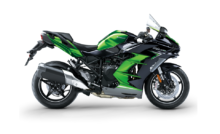2022 Kawasaki KLX110R L Battery Owner’s Manual




2022 Kawasaki KLX110R L Battery


Battery
The battery installed in this motorcycle is a sealed type, so it is not necessary to check the battery electrolyte level or add distilled water. The sealing strip should not be pulled off once the specified electrolyte has been installed in the battery for initial service. However, in order to maximize battery life and ensure that it will provide the power needed to start the motorcycle you must properly maintain the bat- there’s charge. When used regularly, the charging system in the motorcycle helps keep the battery fully charged. If your motorcycle is only used occasionally or for short periods of time, the battery is more likely to discharge. Due to their internal composition, batteries continually self-discharge. The discharge rate depends on the type of battery and ambient temperature. As temperature rises, so does the discharge rate.
In extremely cold weather the fluid in an inadequately charged battery can easily freeze, which can crack the case and buckle the plates. A fully charged battery can withstand sub-freezing temperatures with no damage.
Battery Sulfation
A common cause of battery failure is sulfation. Sulfation occurs when the battery is left in a discharged condition for an extended time. Sulfate is a normal by-product of the chemical reactions within a battery. But when continuous discharge allows the sulfate to crystallize in the cells, the battery plates become permanently damaged and will not hold a charge. Battery failure due to sulfation is not warred printable.
Battery Maintenance
It is the owner’s responsibility to keep the battery fully charged. Failure to do so can lead to battery failure and leave you stranded. If you are riding your vehicle infrequently, inspect the battery voltage weekly using a voltmeter. If it drops below 12.6 volts, the battery should be charged using an appropriate charger (check with a Kawasaki dealer). If you will not be using the motorcycle for longer than two weeks, the battery should be charged using an appropriate charger. Do not use an automotive-type quick charger that may overcharge the battery and damage it.
NOTE
- Leaving the battery connected causes the electrical components to make the battery discharge, resulting in the over-discharge of the battery. In this case, the repair or replacement of the battery is not included in the warranty. If you do not drive for four weeks or more, disconnect the battery from the vehicle.
Kawasaki-recommended chargers are:
- Battery Mate 150-9
- OptiMate 4
- Yuasa MB-2040/2060
- Christie C10122S
If the above chargers are not available, use an equivalent one. For more details, ask a Kawasaki dealer.
Battery Charging
- Remove the battery from the motorcycle (see Bat tery Removal).
- Attach the leads from the charger and charge the battery at a rate (ampere-hours) that is indicated on the battery. If it is not possible to read the rate, charge the battery at an amperage that is about 1/10th of the battery capacity.
- The charger will keep the battery fully charged un- til you are ready to reinstall the battery in the motorcycle (see Battery Installation).
NOTICE
Never remove the sealing strip, or the battery can be damaged. Do not install a conventional battery in this motorcycle, or the electrical system cannot work properly.
- Make
- Furukawa Battery
- Type
- FTH4L-Bs
NOTE
-
- if you charge the sealed battery, never fail to ob- serve the instructions shown on the label on the battery.
WARNING
Lead is a toxic substance. Battery posts, terminals, and related accessories contain lead and lead compounds. Wash hands after handling.
Battery Removal
- Remove the side covers and seat (see Air Cleaner section).
- Remove the bolts and battery holder.
- Pull out the battery a little.
- Disconnect the cables from the battery, first from the(-) terminal and then the (+) terminal.
- Take the battery out.
- Bolts
- Battery Holder
- (-)Terminal
- (+) Terminal
- Battery
- To Leftward
- Clean the battery using a solution of baking soda and water. Be sure that the cable connections are clean.
Battery Installation
- Place the battery.
- Install the battery holder and tighten the bolts.
- Run the white/red cable as shown in the figure.
- Connect the white/red cable to the (+) terminal, and then connect the black cable to the (-) terminal.
NOTICE
Installing the (-) cable to the (+) terminal of the battery or the (+) cable to the (-) terminal of the battery can seriously damage the electrical system.
- Put a light coat of grease on the terminals to prevent corrosion.
- Cover the (+) terminal with its protective cap.
- White/Red Cable
- Protective Cap
- Reinstall the removed parts.
Recent Posts
VW Jetta Engine Fuse Box Diagram
Access the comprehensive 2010-2018 VW Jetta Passenger Fuse Box Diagram to troubleshoot electrical issues effectively.…
VW Jetta Passenger Fuse Box Diagram
Explore the comprehensive VW Jetta Passenger Fuse Box Diagram to troubleshoot electrical issues effectively. Understand…
2023 Ford F-150 Lightning Fuse Box Diagram
Under Hood Fuse Box Location Remove the front luggage compartment cover. Under Hood Fuse Box…
2022 Kawasaki NINJA H2 SX SE Brake Lever Adjuster Owner’s Manual
2022 Kawasaki NINJA H2 SX SE Brake Lever Adjuster Owner's Manual NOTICE Only adjust the front…
2023 Land Rover Range Rover Evoque Exiting The Vehicle Owners Manual
2023 Land Rover Range Rover Evoque Exiting The Vehicle SINGLE LOCKING WARNING Before exiting the…
2023 Land Rover Range Rover Evoque Front Seats Owners Manual
2023 Land Rover Range Rover Evoque Front Seats FRONT SEAT SAFETY Make sure to read…
